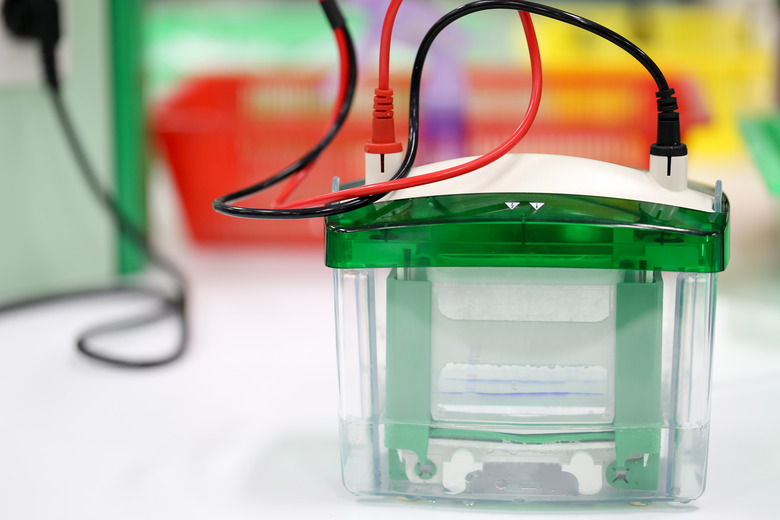Why Is Sodium Used In DNA Extraction?
DNA – deoxyribonucleic acid – is a molecule within the nucleus of a cell that contains genetic information. Extracting DNA involves a series of steps to gently break open the cell, break open the nuclear membrane, separate the DNA from proteins and then cause it to precipitate out of a solution. This is accomplished using various chemicals, based on the structure of membranes, DNA and its electronegativity. Sodium chloride, or other sodium-containing compounds, are used to stabilize the DNA after it has been stripped of its proteins and aid in precipitation.
The Structure of DNA
The Structure of DNA
The basic structure of DNA is two long strands of nucleotides strung together with sugar-phosphate backbones surrounding them. DNA is further arranged by twisting and coiling upon itself, with various proteins associated to keep the strands organized and untangled. In its native state, the portion of DNA most closely exposed to the environment is the sugar-phosphate backbone. Within the cell, that environment is primarily water; in which DNA is soluble. It is soluble in water because of its overall polarity.
DNA Polarity
DNA Polarity
"Polarity" is a chemistry term describing molecules that contain an uneven distribution of electrical charges. According to Paul Zumbo of Cornell Medical College, all nucleic acids are polar. In the case of DNA, the highly polar phosphate groups on the backbone carry negative charges. This property accounts for water solubility, as water is also polar. The positive charges of water interact with the negative charges of DNA and make a solution. To recover DNA for further testing or visualization, the DNA must be precipitated out of a solution with water. Since water has a relatively weak positive charge, this is accomplished by providing a stronger positively charged ion in the solution. Sodium is the perfect candidate for this.
Precipitation of DNA Using Sodium and Alcohol
Precipitation of DNA Using Sodium and Alcohol
Once DNA has been removed from the nucleus of a cell and allowed to mix with water, the introduction of sodium ions creates a temporary attraction between sodium and the backbone. The DNA is temporarily neutralized and then easily disassociated from the water. At this stage the introduction of an alcohol forces the DNA and sodium ions to become even more tightly bonded, since alcohol is very nonpolar. Ethanol or isopropyl alcohol can be used. Once DNA is disassociated from the water and tightly bound to the sodium, it will precipitate out of the solution where it can be either concentrated for purification or visualized by gently spooling it around a smooth glass rod.
Other Steps in DNA Extraction
Other Steps in DNA Extraction
Breaking down the plasma membrane and nuclear membrane to access DNA from cells is usually accomplished by first introducing a detergent of some sort to break up the lipid molecules. A common detergent used in laboratories is SDS, or sodium dodecyl sulfate; but for simple extractions, even dish soap can be used. If the cells are derived from plant material, enzymes are also usually added to digest the cell wall.
Cite This Article
MLA
Taylor, Stacy. "Why Is Sodium Used In DNA Extraction?" sciencing.com, https://www.sciencing.com/sodium-used-dna-extraction-6504902/. 26 April 2018.
APA
Taylor, Stacy. (2018, April 26). Why Is Sodium Used In DNA Extraction?. sciencing.com. Retrieved from https://www.sciencing.com/sodium-used-dna-extraction-6504902/
Chicago
Taylor, Stacy. Why Is Sodium Used In DNA Extraction? last modified August 30, 2022. https://www.sciencing.com/sodium-used-dna-extraction-6504902/
